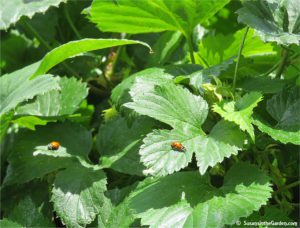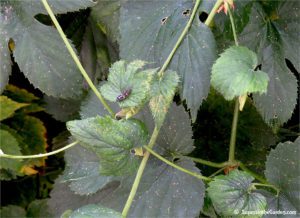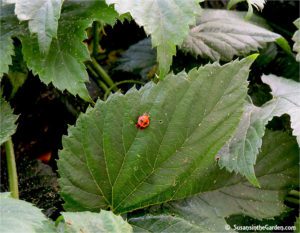Bring on the beneficial insects!

As you know, one of my favorite gardening topics is attracting beneficial insects. My husband Bill and I recently discovered a whole bunch of ladybugs on our hops vines. And boy, were they busily dispatching aphids. It brought an important point to mind:
I love Jessica Walliser’s excellent book, Attracting Beneficial Bugs to Your Garden. She mentioned how she used to be quick to reach for the insect spray whenever she saw a damaging insect.
Then she decided to conduct an experiment. Upon seeing an insect problem in one of her trees, she waited a few days to see what would happen. (think how hard that would be for so many gardeners!)
To her surprise, she discovered beneficial insects had suddenly appeared in her garden and started feasting on the troublesome bugs. No need for that insecticide after all, she realized. Great lesson! She even conducted another experiment with the same results.
All of us want pristine gardens and NO damaging insects, right? Well, actually, if you don’t have some of the bad guys, you’re not going to have the good guys. That’s because those good guys need something to eat.
OK, back to my story about the ladybugs… over the past couple of weeks, while heading to and from the back garden, I’ve been noticing a “sheen” on the leaves of the hop vines. And that can mean only one thing: aphids. Ugh. But I’ve been too busy to even deal with them (not that I would’ve used a spray, mind you).
Then, a few days ago, Bill came and got me as he’d noticed a whole lot of ladybugs on the vines. Problem solved! That’s a good reminder that if we’d only let Mother Nature take care of the occasional problem, we’d be much better off.
As I was photographing the ladybugs on the leaves, I had the opportunity to spot 3 of the stages in their life cycle. Cool! Of course, there was the easily recognizable adult ladybug that we all know and love. Then there were the larvae (which I think look like little alligators) and then I spotted another stage that almost looked like an adult ladybug. That, my friends, was the pupa, a stage that lasts only 5 to 7 days. Check out the photos below so you can recognize these stages as well. (Remember that you can click on any of them to view a larger image.) I didn’t notice any of their bright yellow eggs, but I’m sure they were there and that would be the first stage of their life cycle.



